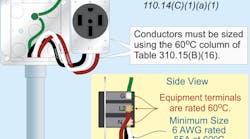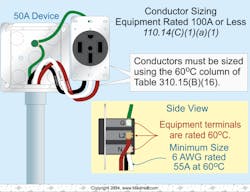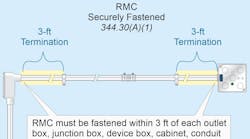Q. What are the conductor sizing requirements as they relate to equipment terminal ratings?
Find the Answer
A. Conductors are to be sized using their ampacity from the insulation temperature rating column of Table 310.15(B)(16) that corresponds to the lowest temperature rating of any terminal, device, or conductor of the circuit [110.14(C)]. Conductors with insulation temperature ratings higher than the termination’s temperature rating can be used for ampacity adjustment, correction, or both.
Unless the equipment is listed and marked otherwise, conductor sizing for equipment terminations must be based on Table 310.15(B)(16) in accordance with 110.14(C)(1) (a) or (b):
Equipment Rated 100A or Less [110.14(C)(1)(a)]
1) Conductors must be sized using the 60°C temperature column of Table 310.15(B)(16) (see Figure)
3) Conductors terminating on terminals rated 75°C are sized in accordance with the ampacities listed in the 75°C temperature column of Table 310.15(B)(16).
4) Motors marked with design letters B, C, or D, conductors having an insulation rating of 75°C or higher can be used, provided the ampacity of such conductors doesn’t exceed the 75°C ampacity.
Equipment Rated Over 100A [110.14(C)(1)(b)]
1) Conductors must be sized using the 75°C temperature column of Table 310.15(B)(16).
2) Separate Connector Provisions. Conductors can be sized to the 90°C column of Table 310.15(B)(16) if the conductors and pressure connectors are rated at least 90°C.
Note: Equipment markings or listing information may restrict the sizing and temperature ratings of connected conductors.





